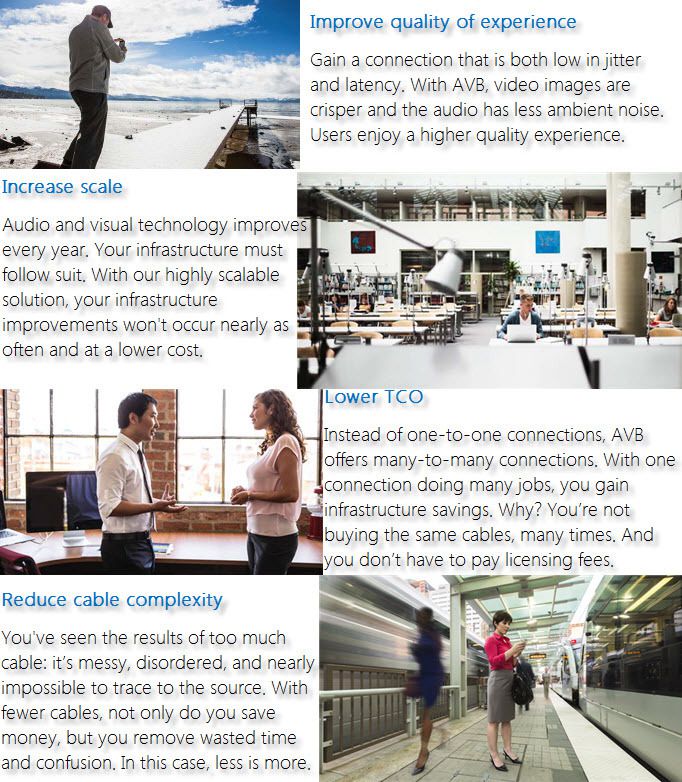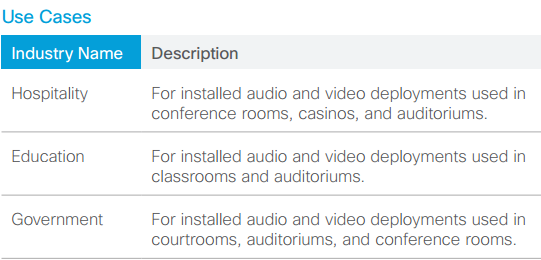What You can Do with Cisco AVB?
Cisco Simplifies Digitization of Audio Video Networks with IEEE Audio Video Bridging
Do you want more audio-video flexibility without spending too much money? If yes, you can try Cisco’s new AVB. What is Audio Video Bridging?

Audio video (AV) equipment deployments have traditionally been single-purpose, analog, point-to-point connections with one-way links. As AV deployments migrate to digital, they have continued to retain this inflexible point to-point architecture. This dedicated connection model also results in a mass of cabling that is difficult and costly to manage. In contrast, an open-standards based Ethernet infrastructure enables flexibility and transparent interoperability of multi-vendor AV equipment and integration of new services.
How did AVB come about, and what does it all mean? AVB is a set of technical standards created by the IEEE Audio Video Bridging Task Group. The IEEE AVB Task Group is a part of the IEEE 802.1 standards committee. IEEE 802.1 defined a set of standards that provided the means for highly reliable delivery of low-latency, time-synchronized AV streaming services through Layer 2 Ethernet networks.

The IEEE 802.1 Audio Video Bridging (AVB) standard enables this digital transition and accelerates the adoption of Ethernet-based AV deployments that are interoperable. The IEEE 802.1 AVB defines a mechanism whereby the endpoints and the network function as a whole. This allows high-quality AV streaming of professional AV over an Ethernet infrastructure. Instead of one-to-one, the network transport enables many-to-many seamless plug-n-play connections for multiple AV endpoints including talkers and listeners. This helps corporations lower total cost of ownership through fewer cables (CapEx) and no license fees for any proprietary technologies (OpEx). It also provides higher quality, time-synchronized AV with more scalability. This scalability includes a more efficient deployment, installation and management enabling new capabilities.
If you want to see how each standard interacts with AVB and for more about the subject, read the “Cisco Audio Video Bridging Design and Deployment for an Enterprise Network” white paper.

Cisco simplifies digitization of AV networks with AVB support on industry leading switches. With the Cisco IOS XE Software Release 16.3, Cisco has introduced support for the IEEE 802.1 AVB standard on select Cisco Catalyst 3850 and select Cisco Catalyst 3650 switches. It delivers the highest-capacity 1-,10- and 40-Gigabit Ethernet ports in the industry.

Cisco implements the AVB standards on select Catalyst 3850 and 3650 Series Switches.
The Catalyst 3850 and 3650 Series Switches include our widely deployed, industry leading managed access and aggregation switches. They are designed to deliver a comprehensive set of features to provide the best application experience, the highest levels of security, precise control and management of the network. They offer industry-leading scalability in the fixed configuration category of switches. As a result, they can be deployed as aggregation or access switches in large networks or as core switches in smaller networks.
Cisco’s Unified Access Data Plane application-specific integrated circuit (ASIC) powers the switches and can enable uniform wired-wireless policy enforcement, application visibility and control (AVC), flexibility and application optimization. Cisco Catalyst 3850 and 3650 Series Switches support full IEEE 802.3at Power over Ethernet Plus (PoE+), Cisco Universal Power over Ethernet, modular and field-replaceable network modules, RJ45 and fiber-based downlink interfaces, redundant fans and power supplies and innovative power-sharing functions to achieve a flexible and advanced redundant configuration. With speeds that reach 10 Gbps, Cisco Catalyst 3850 Multigigabit Ethernet Switches support current and next-generation wireless speeds and standards—including 802.11ac Wave 2—on existing cabling infrastructure.
Quite simply, these switches are designed to deliver a comprehensive set of features to provide the best application experience, the highest levels of security, and precise control and management of the network.
The Cisco Catalyst 3850 and 3650 switches offer industry-leading scalability in the fixed configuration category of switches. As a result, they can be deployed as aggregation or access switches in large networks or as core switches in smaller networks.

Cisco has also added rich next-generation capabilities to this platform.
Some examples include:
- Programmability
- AVB
- MPLS
- Services discovery gateway
- Network as a sensor and enforcer
- Encapsulated remote switchport analysis
Try using a Cisco Catalyst 3850 and 3650 Series switches to provide AVB. Whether you're in hospitality, government, enterprise or another industry, Cisco AVB is an ideal solution. Deploy it into your current audio-video setup: in conference rooms, auditoriums, and more.
Reference From http://www.cisco.com/c/dam/en/us/products/collateral/switches/at-a-glance-c45-737488.pdf
More Related:
Updated: Comparing the Newest Cisco 3850 Models
The New Cisco Catalyst 3650 Series Mini Switch
The Newest: Model Comparison for the Cisco Catalyst 3650 Models



/image%2F1490247%2F20190327%2Fob_8eebea_networking-for-digital-intro.png)
/image%2F1490247%2F20190322%2Fob_2f91e9_802-11ac-vs-802-11ax.png)
/image%2F1490247%2F20190228%2Fob_15918d_cat9200.png)
/image%2F1490247%2F20190214%2Fob_219b31_cisco-900-series.jpg)
